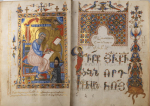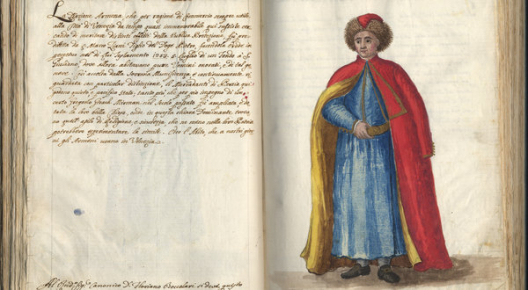EXHIBITION REVIEW: The Key to Armenia's Survival
 VENICE — Armenian civilization is one of the most ancient of those surviving in the Middle East, but for large parts of its history Armenia has been a nation without a country. This has given the spoken and written word, the primary means through which Armenian identity has been preserved, enormous prominence in its people’s culture.
VENICE — Armenian civilization is one of the most ancient of those surviving in the Middle East, but for large parts of its history Armenia has been a nation without a country. This has given the spoken and written word, the primary means through which Armenian identity has been preserved, enormous prominence in its people’s culture.
Over the centuries this emphasis has fostered a particular regard for books and the means of producing them. Scribes added notes on the proper care and conservation of books and advice on hiding them during dangerous times, even on “ransoming” them should they fall into the wrong hands. A late 19th-century English traveler observed that the Armenians prized the printing press with the same “affection and reverence as the Persian highlanders value a rifle or sporting gun.”


In 1511 to 1512 (the exact date is uncertain), the first Armenian book was printed in Venice. The event was especially significant for this scattered nation, which did not acquire a modern homeland until 1918 and then only in a small part of its ancestral lands.
The anniversary is the occasion for “Armenia: Imprints of a Civilization,” an impressive exhibition organized by Gabriella Ulluhogian, Boghos Levon Zekiyan and Vartan Karapetian of more than 200 works spanning more than 1,000 years of Armenian written culture. These range from inscriptions and illuminated manuscripts to printed and illustrated books, including many unique and rare pieces from collections in Armenia and Europe.
The show opens with the atmospheric painting of 1889 by the Armenian artist Ivan Aivazovski, “The Descent of Noah From Mount Ararat,” from the National Gallery in Yerevan. It shows the Old Testament patriarch leading his family and a procession of animals across the plain, still watery from the subsiding Flood, to re-people the earth.
The extraordinary grip that this mountain has had on the Armenian imagination is tellingly demonstrated by subsequent sections on sculpture, the Armenian Church and the Ark — the conical domes of Armenian churches seeming eternally to replicate this geographical feature that symbolizes the salvation of the human race.
Christianity reached Armenia as early as the first or early second century. And Armenia lays claim to having been the first nation that adopted the faith as a state religion, sometime between 293 and 314, a date traditionally recorded by the Armenian Church as 301.
There followed, in around 404 or 405, an initiative that has been one of the cornerstones of the endurance of the Armenian ethnos: the invention of a distinctive alphabet capable of rendering the language’s complex phonetic system. This made possible the translation of the Bible — the majestic 10th-century Gospel of Trebizond is on show here — and the foundation of Armenian literature in all its manifestations, sacred and secular.
The desire to illustrate the gospels and other Christian texts was the primary impetus for the development of Armenian art, which drew on an unusually wide range of sources thanks to the country’s position at the crossroads of several civilizations.
As Dickran Kouymjian writes in his essay in the exhibition’s substantial and wide-ranging catalog, which is available in English, French and Italian: “Armenian artists were remarkably open to artistic trends in Byzantium, the Latin West, the Islamic Near East and even Central Asia and China.”
A sumptuous display of these illuminated books brings together some of the finest surviving examples from the ninth to the 15th centuries, and it is curious to discover that even after the advent of printing, the tradition of illumination continued in Armenian monasteries for a further two and a half centuries.
The acme of the Armenian miniature was reached in the 13th century, during the Armenian Kingdom of Cilicia, which ruled over a substantial part of Asia Minor (1198-1375), until it was overthrown by the Mamluks of Egypt.
http://www.nytimes.com/2012/02/24/arts/24iht-conway24.html?_r=2
• ՀՈԴՎԱԾՆԵՐԸ ՄԱՍՆԱԿԻ ԿԱՄ ԱՄԲՈՂՋՈՒԹՅԱՄԲ ԱՐՏԱՏՊԵԼՈՒ ԿԱՄ ՕԳՏԱԳՈՐԾԵԼՈՒ ԴԵՊՔՈՒՄ ՀՂՈՒՄԸ www.anunner.com ԿԱՅՔԻՆ ՊԱՐՏԱԴԻՐ Է :
• ԵԹԵ ԴՈՒՔ ՈՒՆԵՔ ՍՈՒՅՆ ՀՈԴՎԱԾԸ ԼՐԱՑՆՈՂ ՀԱՎԱՍՏԻ ՏԵՂԵԿՈՒԹՅՈՒՆՆԵՐ ԵՎ
ԼՈՒՍԱՆԿԱՐՆԵՐ,ԽՆԴՐՈՒՄ ԵՆՔ ՈՒՂԱՐԿԵԼ ԴՐԱՆՔ info@anunner.com ԷԼ. ՓՈՍՏԻՆ:
• ԵԹԵ ՆԿԱՏԵԼ ԵՔ ՎՐԻՊԱԿ ԿԱՄ ԱՆՀԱՄԱՊԱՏԱՍԽԱՆՈՒԹՅՈՒՆ, ԽՆԴՐՈՒՄ ԵՆՔ ՏԵՂԵԿԱՑՆԵԼ ՄԵԶ` info@anunner.com:
Դիտումների քանակը: 2162
| Կիսվել : |

«Ցեղի կանչը». Գագիկ Գինոսյան

ՏԻԳՐԱՆ ՀԱՄԱՍՅԱՆ



















 Arian AMU
Arian AMU
